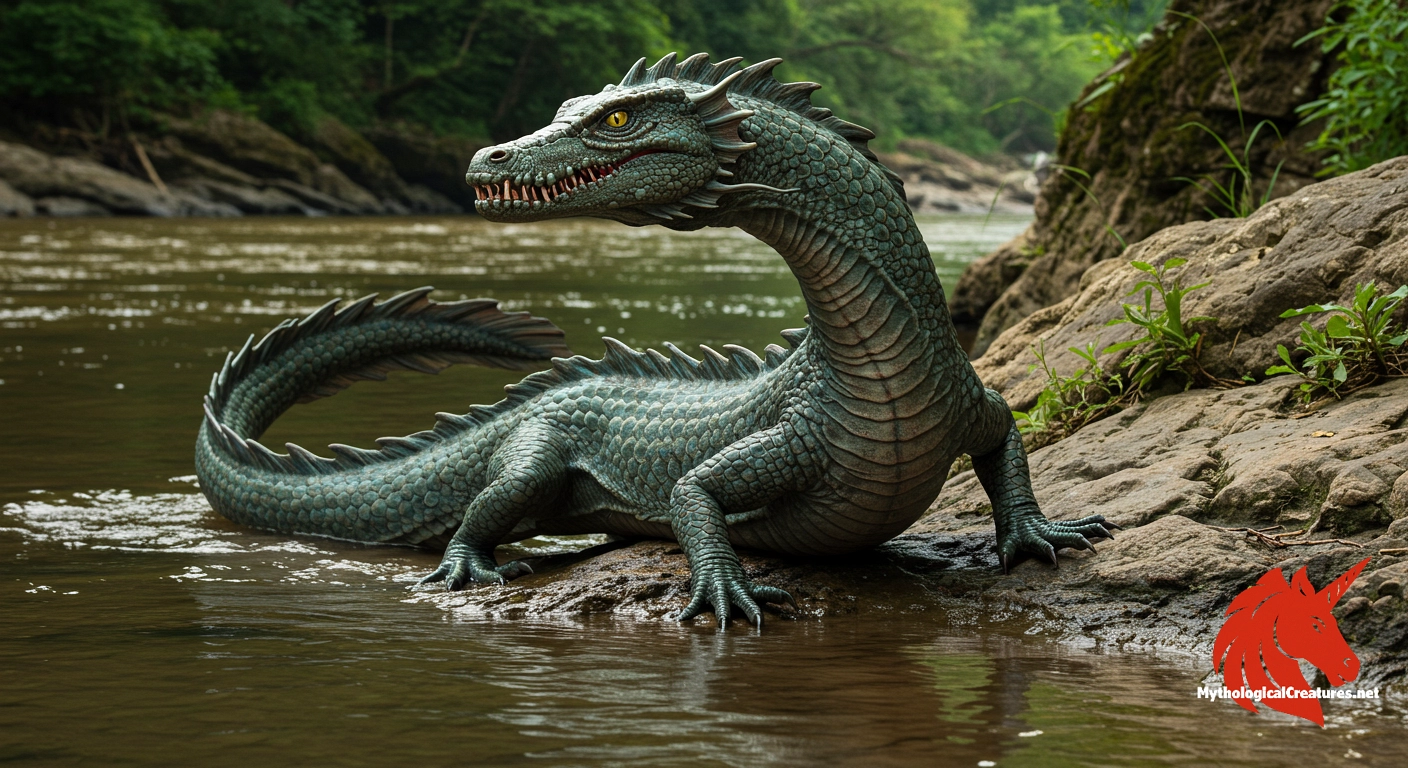Jiaolong: Jiaolong is a hornless, scaled dragon from Chinese mythology renowned for its aquatic and river-dwelling nature.

Jiaolong
Jiaolong - Jiaolong represents ancient fears of destructive aquatic forces and plays a role in cultural practices, such as the protective tattoos of the Yue people.
Origins & First Encounters
Jiaolong occupies a unique space in Chinese mythology as an enigmatic aquatic dragon distinguished by its scaleless elegance. Its origins appear to blend indigenous myth with influences from neighbouring non-Sinitic cultures, particularly those of southern peoples. The earliest attestation of Jiaolong can be traced to ancient texts and oral traditions where the creature was portrayed as both fearsome and enigmatic. Unique among dragon lore, Jiaolong is often cited as hornless, a characteristic that sets it apart from the more familiar celestially-inspired beings. Historical accounts indicate that Jiaolong may have been associated with river deities and ancient water rituals, suggesting a strong link to the natural world’s untamed power. The creature’s recurring appearance in various legends underscores its cultural resonance over centuries in Chinese folklore. Over time, the Jiaolong has evolved from a purely mythic symbol to one embodying the unpredictable forces of water and flood. Its multifaceted cultural significance continues to fascinate storytellers, making Jiaolong a revered emblem in both ancient and modern lore.
Source Texts & Tale Variants
The primary sources describing Jiaolong are diverse, ranging from ancient Chinese dynastic records to folklore passed down through generations. Early literary sources hinted at its aquatic nature, often describing it as a scaled, hornless dragon that presided over floodwaters and riverbanks. In some records, the creature is conflated with local crocodilian species, indicating that its mythological identity may have been influenced by encounters with real animals. There are notable variations in the myth as it appears in different texts, with one version emphasising its formidability as a water spirit while another highlights its role as a guardian against floods. Some of the earliest accounts were inscribed on bronzeware and oracle bones, providing insights into ancient Chinese cosmology and natural phenomena. Oral traditions among the Yue people also play a significant role in the beast’s narrative, where tattooing was reputedly used as a form of protection. These varied representations indicate that Jiaolong’s story was not static, but rather a living myth that absorbed new elements over time. As scholars continue to examine these primary texts, the layered history of Jiaolong remains emblematic of the dynamic interplay between history and myth.
Form & Powers
The physical depiction of Jiaolong is richly detailed and characterised by a pronounced set of scales that shimmer with an intriguing aquatic gloss. Traditionally, this dragon is described as hornless, a departure from the more iconic imagery of its celestial cousins. Its elongated, sinuous body suggests an inherent grace despite its association with the chaotic forces of water. The creature’s anatomy is often compared to that of a crocodile, with robust limbs adapted to both swimming and subduing adversaries. Detailed narratives in some texts recount a creature whose eyes gleam with intelligence and whose skin is impervious to the rapid flow of river currents. Its scales, arranged in meticulously defined patterns, evoke an artistry that mirrors the natural beauty of riverbeds. The physical size of Jiaolong, while variable in different legends, is usually portrayed as imposing, yet its agility in water speaks to a balanced form of strength and elegance. This composite of reptilian and dragon-like features makes Jiaolong one of the more visually arresting entities in Chinese mythology.
Regional Faces
Stories of Jiaolong present fascinating regional variations that reflect the local cultural and environmental influences across China and its southern neighbours. In the southern regions, particularly among the Yue peoples, Jiaolong is often depicted with a closer affinity to crocodilian creatures, hinting at their interactions with similar fauna in the wild. Northern and central traditions, in contrast, tend to abstract the creature into a more mythological figure representing flood control and celestial balance. In some locales, Jiaolong is presented as a benign protector of water sources, while in others it symbolizes a destructive force that must be appeased through ritual. These regional adaptations allowed communities to integrate the creature into diverse local cosmologies and natural explanations for water-related phenomena. The physical appearance and behavioural traits may also shift subtly, with descriptions adapting to mirror local wildlife and natural wonders. Such variations underscore the adaptability of myth, where a single creature can embody either benevolence or malevolence depending on regional needs. Ultimately, these differing portrayals illustrate how Jiaolong has been reinterpreted and reshaped across geographic and cultural boundaries.
Cultural Parallels
When compared with other mythological beings, Jiaolong stands out for its distinct amalgamation of aquatic and draconic attributes. Similar to the serpentine Naga of South Asia, Jiaolong bridges the realms of land and water, blending natural ferocity with an almost meditative poise. Unlike the Western dragon, which is often depicted with wings and fiery breath, Jiaolong’s identity is rooted in its watery domain and hornless visage. European mythologies sometimes refer to aquatic creatures as krakens, yet Jiaolong is more elegantly scaled and less monstrous in its presentation. Both in Eastern and Western traditions, these creatures often serve as metaphors for the unpredictability of natural forces, be it flood or storm. A cross-cultural examination reveals that dragons and dragon-like beings frequently embody the dualistic nature of creation and destruction. Moreover, while the Naga and other serpentine myths tend to convey a spiritual guardianship, Jiaolong’s connection to the physical world is emphasised by its tangible crocodilian traits. Such comparative analysis enriches our understanding of how diverse cultures have used similar imagery to reconcile human existence with the power of nature.
Legacy & Modern Evolution
The evolution of Jiaolong’s depiction has followed a fascinating trajectory from ancient ritualistic iconography to contemporary cultural symbolism. Over the centuries, the creature has transitioned from an interpretation of natural phenomena, such as floods and river dynamics, to a more emblematic role that represents the mysteries of water. In modern reinterpretations, Jiaolong is often celebrated in art, literature, and even media adaptations, embodying both the ancient and the fantastical. Its continued presence in festivals and folk art in various parts of China reinforces its importance as a cultural signifier. The dragon’s form has influenced modern design elements in film and video games, where the Jiaolong is reimagined with creative liberties yet retains its aquatic essence. Urban art and public sculptures occasionally draw on its imagery, reflecting a deep-seated admiration for its storied past. Scholars and cultural enthusiasts alike note that the enduring legacy of Jiaolong lies in its ability to mirror society’s complex relationship with the natural world. In a bygone era, it symbolised both the blessings and perils of water, and today it continues to inspire awe and mystery in a modern context.
Interesting Fact
An intriguing aspect of Jiaolong is its association with body tattoos among the Yue people, highlighting its cultural impact beyond mere myth.
Quick Creature Info
Associations:
Our Mythic Legendary Rating:

Also Sometimes Known As:
Habitat:
Supernatural Powers:
Physical Attributes:
Abilities:
Behavior:
Lore:
Related Creatures, Tales or Lore
- CChinese Dragon (Long)
- NNaga
- RRyujin
References
Discover Another Mythical Legend You May Not Have Heard Of?
Uncover the mysteries of ancient folklore and expand your knowledge of legendary beings from cultures around the world.
Dare to Meet the Sigrún....
Mythical Disclaimer: The images and data on this site are derived from various historical and literary sources, but we have found that many myths often have multiple versions and interpretations across references, sometimes contradictory. As a result, these creature depictions are artistic interpretations—imaginative blends of folklore, legend, and a dash of AI guesswork. Because creature descriptions vary widely, our illustrations and accompanying information represent our best effort to honor mythology while bridging creative gaps. Enjoy these interpretations—just remember, we've done our best to respect the stories and validate available data, but in the realm of mythology, details often shift, imagination leads the way, and nothing is ever set in stone!
Curated by the Mythological Creatures Team (rev. May 2025)
